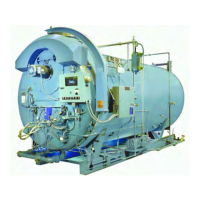Chapter 2 — Burner Operation and Control
2-20 Part No. 750-184
M. GAS FUEL FLOW
Metered gas from the utility flows through the pressure regulator at
a reduced pressure suitable to burner requirements, through the
main gas shutoff cock, main gas valve(s), and modulating butterfly
gas valve to the non- premix orifice-type burner.
The main gas valve is of the normally closed type, and is opened
(energized) in proper sequence by the programming relay.
The butterfly gas valve modulates the flow of gas from low through
high fire settings. The position of the butterfly valve disc is governed
by the gas modulating cam. The butterfly gas valve, and the air
control damper are controlled simultaneously by the modulating
motor to proportion combustion air and fuel for changes in load
demand.
The gas flow rate required for rated burner input depends upon the
heating value (Btu/cubic foot) of the gas supplied. The gas pressure
regulator adjusts the gas pressure (flow rate) to the entrance of the
gas train. The regulator is not always supplied with the burner, but
may be provided by others.
The main gas valves cannot be energized (opened) unless the
combustion air proving switch is closed to indicate a sufficient
supply of combustion air. The low gas pressure and high gas
pressure switches must be closed to prove sufficient, but not
excessive, gas fuel pressure.
N. MODULATING FIRING
The modulating motor, through a linkage arrangement, controls the
air damper and the butterfly gas valve (or the oil metering valve) to
maintain a constant air/fuel ratio throughout the firing range.
During burner operation, the motor is controlled by a modulating
pressure control on a steam boiler, or by a modulating temperature
control on a hot water boiler. A manually operated potentiometer is
provided to permit positioning of the motor at the desired burner
firing rate. The potentiometer is used primarily for initial or
subsequent checking and setting of fuel input. Normal operation
should be with the manual-automatic switch in the “automatic”
position and under the control of the modulating control.
The modulating motor (commonly called a damper motor) is
reversible. It has an internal limit switch that restricts shaft rotation
to 90°. During normal operation the motor will move in either
direction or stop at any position within the range.
The motor potentiometer is electrically connected to a matching
potentiometer in the modulating control. Changing steam pressure
or water temperature alters the electrical resistance of the
modulating controller potentiometer. The change in resistance
compels an integral balancing relay to start, stop, or reverse the
motor rotation. Rotation in either direction continues until the
resistance ratio of the two potentiometers is equal.

